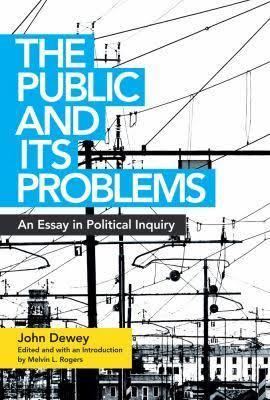7.8 /10 1 Votes
Country United States Publication date 1927 Pages 195 Publisher Henry Holt and Company Subject Political philosophy | 3.9/5 Goodreads Language English Media type Print Originally published 1927 Page count 195 Genre Non-fiction | |||||||||||||||||||||||||||||||||
 | ||||||||||||||||||||||||||||||||||
Similar Works by John Dewey, Political philosophy books, Democracy books | ||||||||||||||||||||||||||||||||||
The Public and its Problems is a 1927 book by American philosopher John Dewey. In this work, Dewey touches upon major political philosophy questions that have continued into the 21st century, specifically: can democracy work in the modern era? Is there such a thing as a "public" of democratic citizens, or is the public a phantom, as journalist Walter Lippmann argued in his 1925 book The Phantom Public (and to which The Public and its Problems was a direct response).
Overview
Dewey begins his argument by distinguishing between the "state," represented by elected lawmakers, and the "public," the diffuse, often incoherent body of citizens who elect the state. The public is called into being when ordinary citizens experience the negative externalities (or consequences) of exchanges beyond their control (such as market or governmental activities). A public then is made up of citizens whose common interest is focused on alleviating these negative externalities through legislation; in fact, Dewey argues that a public does not actually exist until a negative externality calls it into being.
Dewey asserts that this occurs when people perceive how consequences of indirect actions affect them collectively: “Indirect, extensive, enduring and serious consequences of conjoint and interacting behavior call a public into existence having a common interest in controlling these consequences”. Hence, a public only develops when it has a reason and comes together around an issue of substantial or serious significance.
In the second half of The Public and its Problems, Dewey concedes to the arguments of adversaries of modern democracy (such as Walter Lippmann) by describing all the powerful forces at work that eclipse the public and prevent it from articulating its needs. For example, Dewey explains how special interests, powerful corporate capital, numbing and distracting entertainment, general selfishness, and the vagaries of public communication make effective public deliberation difficult.
Whereas Walter Lippmann believed that the public had little capacity to be a rational participant in democracy and was essentially nonexistent, Dewey held a more optimistic view of the public and its potential. Dewey did not call for an abandonment of the public; rather, he hoped the public would regain a sense of self. The solution to this, he writes, is improved communication. Only then, with communication, will the public find itself and become a cohesive group.
In addition to Dewey's proposition that the public cannot find itself because there are too many publics, he also blames the distractions of modern society. He points out that even in the past, the public has had other concerns than politics: "Political concerns have, of course, always had strong rivals". In discussing the distractions of the past, Dewey explains that those distractions are far more prevalent and bountiful in today's society and citing technology as the main perpetrator.
He uses examples of "the movie, cheap reading matter and [the] motor car as drawing peoples' attention away from politics. These technologies, Dewey explains, are far more desirable topics of discussion for the everyday person than the latest political news. Unfortunately, Dewey does not give a solution to the problem of technology taking away from interest in political affairs. However, Dewey does have hopes that society can someday use its technology to improve communication and thus improve public interest in politics.
Furthermore, he asserts that local community is where democracy must happen so that people can become active and express issues of public concern. In this way, the local community can become the “Great Community.” He writes, “Without such communication the public will remain shadowy and formless…Till the Great Society is converted into a Great Community, the Public will remain in eclipse. Communication can alone create a great community”.
